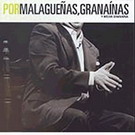Refrain that we sing to end some songs.
Macho
Malagueñas, The
Malagueñas is one of the traditional styles of flamenco, derived from earlier types of fandango from the area of Málaga, classified among the Cantes de Levante. Originally a folk-song type, it became a flamenco style in the 19th century. It is not normally used for dance, as it is generally interpreted with no regular rhythmic pattern, as a "cante libre". It has a very rich melody with virtuous flourishes and use of microtones. Its guitar accompaniment is normally played in open position first inversion giving E for the tonic, which can be transposed by using a capo.
Malagueñas derive from local variety of the Fandangos, a type of dance that, with different regional variations and even different names, became very popular in great part of Spain in the 18th century. Although nowadays malagueñas are a typical instance of "cante libre", performed at libitum and normally not used for the dance, folkloric fandangos were originally sung and played at a fast speed, with a rhythmic pattern in 6/8, to accompany dance. Some of these primitive fandangos from Málaga, called Verdiales are still performed nowadays at folkloric gatherings by large non-professional groups called "Pandas", which use a high number of guitars, "bandurrias" (a sort of mandoline), violins, and tambourines.
Marianas
Coming from the "aflamencamiento" of an Andalusian song. A flamenco palo, music style: singing and Spanish dancing. Binary palo, from de tangos group. The popular acceptance if this song begun on the XX. Century.
Martinete
Coming from the Tonás group (a palo seco), possible accompaniment of the anvil and the hammer. A flamenco palo, musical style: singing and Spanish dancing. Generally a song with copla of four octosyllable verses.
Generally with sad content, with long whines.
Mayor
Western form of the musical harmony, very present in the flamenco.
Media
A flamenco palo, singing and Spanish dancing musical style. Copla with five octosyllable lines, consonant rhyme. We usually repeat one of them (the first or second one) during the singing. It belongs to the "Levante" songs style. We think that its creator is Antonio Chacón.
Media Granaína, Medium Granaina
The medium "granaina", should be from Granada if we trust its name, but they come from the old fandango (verdial) originated in Ronda and Malaga and then they arrived to Granada. Therefore we include the medium "granaina" among the styles from Malaga. Song with a clear melodic line. The flourish of the voice is the bridge to the tone changes.
Melisma
Melisma, in music, is the singing of a single syllable of text while moving between several different notes in succession. Music sung in this style is referred to as melismatic, as opposed to syllabic, where each syllable of text is matched to a single note.
Menor
Form of the musical harmony coming from the West, present in the flamenco.
Milonga, The
Milonga can refer to an Argentine, Uruguayan, and Southern Brazilian form of music which preceded the tango and the dance form which accompanies it, or to the term for places or events where the tango or Milonga are danced (see Milonga (place)). The term milonga comes from a similar expression that means "lyrics".
The Milonga originated in the Río de la Plata area of Argentina and Uruguay and has its roots from various European music. It was very popular in the 1870s. The Milonga was derived from an earlier style of singing known as the payada de contrapunto.
The song was set to a lively 2/4 tempo, and often included musical improvisation. Over time, dance steps and other musical influences were added, eventually giving rise to the tango. Despite 2/4 formula, rhythm is irregular. It is syncopated, consisting of 8 beats with accents on the 1st, (sometimes also 2nd) 4th, 5th, and 7th beats.


